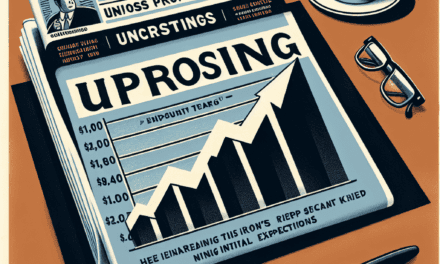“Boeing: Navigating New Horizons Through Strategic Asset Realignment”
Introduction
Boeing Begins Asset Liquidation: In a significant move reflecting the ongoing challenges faced by the aerospace giant, Boeing has initiated a strategic asset liquidation process. This decision comes amid a turbulent period marked by financial strain, production setbacks, and evolving market dynamics. The liquidation aims to streamline operations, reduce debt, and reallocate resources to core business areas, ensuring long-term sustainability and competitiveness. As Boeing navigates this complex transition, the industry watches closely, understanding that the outcomes could reshape the aerospace landscape and influence future corporate strategies within the sector.
Impact Of Boeing’s Asset Liquidation On The Aviation Industry
Boeing’s recent decision to initiate asset liquidation marks a significant turning point in the aviation industry, with far-reaching implications for various stakeholders. As one of the largest aerospace manufacturers globally, Boeing’s actions are poised to influence market dynamics, supply chains, and competitive landscapes. This move, while primarily a strategic financial decision, is expected to reverberate across the aviation sector, prompting both challenges and opportunities for industry players.
To begin with, Boeing’s asset liquidation is likely to impact the supply chain significantly. As Boeing divests certain assets, suppliers who have long relied on the company for business may face uncertainty. This could lead to disruptions in the production schedules of various aircraft components, affecting not only Boeing’s operations but also those of other manufacturers who share the same suppliers. Consequently, suppliers may need to diversify their client base to mitigate risks associated with Boeing’s reduced demand, potentially leading to a reshuffling of partnerships within the industry.
Moreover, the liquidation process may alter competitive dynamics within the aviation sector. As Boeing sells off assets, competitors might seize the opportunity to acquire valuable resources, such as technology, patents, or production facilities. This could enable other aerospace companies to enhance their capabilities, thereby intensifying competition. Additionally, new entrants might emerge, leveraging acquired assets to establish a foothold in the market. This shift could lead to increased innovation and efficiency as companies strive to capitalize on newly available resources.
Furthermore, Boeing’s decision may have financial implications for the aviation industry. The liquidation of assets is likely to affect Boeing’s stock performance, influencing investor sentiment and potentially impacting the broader market. Investors may reassess their portfolios, considering the long-term viability of aerospace investments. This could lead to fluctuations in stock prices of not only Boeing but also its competitors and suppliers. Financial institutions and analysts will closely monitor these developments, as they could signal broader trends in the industry’s economic health.
In addition to financial considerations, Boeing’s asset liquidation may have regulatory implications. As assets change hands, regulatory bodies will need to ensure compliance with industry standards and safety regulations. This could result in increased scrutiny and oversight, particularly if new players enter the market. Regulatory agencies may need to adapt to the evolving landscape, ensuring that safety and quality are maintained amidst the changes.
On a broader scale, Boeing’s decision may influence employment within the aviation sector. As assets are sold and operations potentially scaled back, there could be workforce reductions at Boeing. However, this may be offset by job creation at companies acquiring these assets, as they expand their operations. The net effect on employment will depend on how effectively the industry adapts to the changes and how quickly new opportunities arise.
In conclusion, Boeing’s asset liquidation is a multifaceted development with significant implications for the aviation industry. While it presents challenges, such as supply chain disruptions and regulatory adjustments, it also offers opportunities for increased competition and innovation. As the industry navigates this transition, stakeholders will need to remain agile and responsive to the evolving landscape. Ultimately, the impact of Boeing’s decision will depend on how effectively the industry adapts to these changes, shaping the future of aviation in the process.
Reasons Behind Boeing’s Decision To Liquidate Assets
Boeing’s recent decision to initiate asset liquidation has sent ripples through the aerospace industry, prompting analysts and stakeholders to scrutinize the underlying reasons for such a significant move. This strategic shift, while surprising to some, is rooted in a confluence of factors that have been shaping the company’s trajectory over recent years. Understanding these reasons requires a closer examination of Boeing’s current financial landscape, market dynamics, and broader industry challenges.
To begin with, Boeing has been grappling with financial pressures exacerbated by the prolonged grounding of its 737 MAX aircraft. The grounding, which followed two tragic crashes, not only tarnished the company’s reputation but also led to substantial financial losses. Despite efforts to rectify the issues and regain regulatory approval, the financial impact has been profound, necessitating a reevaluation of Boeing’s asset portfolio. By liquidating certain assets, Boeing aims to bolster its liquidity position, providing a buffer against ongoing financial strains and enabling the company to focus on its core operations.
Moreover, the COVID-19 pandemic has further compounded Boeing’s challenges, as the global aviation industry faced an unprecedented downturn. With airlines reducing orders and deferring deliveries, Boeing experienced a significant decline in demand for new aircraft. This downturn has forced the company to reassess its production capacities and asset allocations. Liquidating non-essential assets allows Boeing to streamline its operations, reduce overhead costs, and align its resources with the current market realities. This strategic realignment is crucial for maintaining competitiveness in an industry that is slowly recovering from the pandemic’s impact.
In addition to these immediate financial and market pressures, Boeing’s decision is also influenced by the need to invest in future technologies and innovations. The aerospace industry is on the cusp of transformative changes, with advancements in sustainable aviation, autonomous flight, and digitalization. To remain at the forefront of these developments, Boeing must allocate resources towards research and development initiatives. By liquidating underperforming or non-strategic assets, the company can redirect capital towards these forward-looking projects, ensuring its long-term viability and leadership in the industry.
Furthermore, Boeing’s asset liquidation strategy is part of a broader effort to enhance operational efficiency and agility. In an increasingly competitive market, the ability to adapt quickly to changing conditions is paramount. By shedding non-core assets, Boeing can streamline its organizational structure, improve decision-making processes, and focus on areas with the highest growth potential. This approach not only strengthens the company’s financial position but also positions it to respond more effectively to emerging opportunities and challenges.
Lastly, it is important to consider the role of shareholder expectations in Boeing’s decision-making process. As a publicly traded company, Boeing is accountable to its investors, who demand sustainable growth and profitability. Asset liquidation can be a strategic tool to deliver value to shareholders by optimizing the company’s asset base and enhancing its financial performance. By demonstrating a proactive approach to managing its resources, Boeing aims to restore investor confidence and support its long-term strategic objectives.
In conclusion, Boeing’s decision to liquidate assets is driven by a combination of financial, market, technological, and strategic factors. While the move may seem drastic, it reflects a calculated effort to navigate current challenges and position the company for future success. As Boeing embarks on this path, the industry will be watching closely to see how these changes unfold and what they mean for the future of one of the world’s leading aerospace manufacturers.
How Boeing’s Asset Liquidation Affects Its Global Workforce
Boeing’s recent decision to initiate asset liquidation marks a significant shift in the aerospace giant’s strategic approach, with profound implications for its global workforce. This move, primarily driven by the need to streamline operations and address financial challenges, is poised to reshape the company’s organizational structure and influence the livelihoods of thousands of employees worldwide. As Boeing embarks on this path, it is crucial to understand the multifaceted impact on its workforce, which spans across continents and encompasses a diverse range of roles and responsibilities.
To begin with, asset liquidation typically involves the sale of non-core assets, including real estate, machinery, and other physical properties. For Boeing, this process is expected to generate much-needed capital, which can be redirected towards core business areas such as research and development, production, and innovation. However, the immediate consequence of such a move is the potential displacement of employees who are directly associated with the assets being liquidated. For instance, workers stationed at facilities earmarked for sale may face relocation or, in some cases, redundancy. This creates a ripple effect, as affected employees must navigate the uncertainties of job transitions, often requiring retraining or upskilling to align with new roles within the company or elsewhere.
Moreover, the liquidation process may lead to a re-evaluation of Boeing’s global supply chain and manufacturing footprint. As the company seeks to optimize its operations, it may choose to consolidate certain functions or outsource specific activities to third-party providers. This strategic realignment could result in job losses in regions where Boeing decides to scale back its presence. Conversely, it might also create new opportunities in areas where the company intends to concentrate its efforts. Consequently, employees must remain adaptable and proactive in seeking opportunities that align with Boeing’s evolving business model.
In addition to the direct impact on employment, Boeing’s asset liquidation has broader implications for employee morale and organizational culture. The uncertainty surrounding job security can lead to decreased motivation and productivity among the workforce. To mitigate these effects, Boeing must prioritize transparent communication and provide support mechanisms for affected employees. This includes offering career counseling, facilitating internal job placements, and ensuring that employees have access to resources that aid in their professional development. By fostering a supportive environment, Boeing can help maintain employee engagement and loyalty during this transitional period.
Furthermore, the global nature of Boeing’s operations means that the effects of asset liquidation will vary across different regions. In countries with robust labor protections and social safety nets, employees may find it easier to transition to new roles or industries. However, in regions with less developed support systems, the impact on workers could be more severe, necessitating targeted interventions from both Boeing and local governments to cushion the blow.
In conclusion, Boeing’s asset liquidation represents a pivotal moment for the company and its global workforce. While the move is aimed at strengthening Boeing’s financial position and ensuring long-term sustainability, it also presents significant challenges for employees who must navigate the uncertainties of a changing organizational landscape. By prioritizing transparent communication, providing support for affected workers, and fostering a culture of adaptability, Boeing can help mitigate the adverse effects of this transition and position itself for future success. As the company moves forward, it will be essential to balance financial imperatives with the well-being of its workforce, ensuring that employees remain a central focus in its strategic endeavors.
Financial Implications Of Boeing’s Asset Liquidation

Boeing’s recent decision to initiate asset liquidation marks a significant shift in the aerospace giant’s financial strategy, reflecting broader implications for the industry and its stakeholders. This move, while unexpected by some, is a calculated response to the evolving economic landscape and the company’s internal financial pressures. As Boeing embarks on this path, it is crucial to understand the financial implications that accompany such a substantial decision.
To begin with, asset liquidation typically involves selling off company assets to generate cash. For Boeing, this could mean divesting non-core business units, real estate, or even surplus inventory. The primary objective is to bolster liquidity, allowing the company to meet its immediate financial obligations and invest in areas that promise higher returns. In the short term, this strategy can provide a much-needed cash influx, which is particularly beneficial in times of economic uncertainty or when facing unexpected financial challenges.
Moreover, the decision to liquidate assets can also be seen as a strategic realignment. By shedding non-essential assets, Boeing can streamline its operations and focus on its core competencies, such as commercial aircraft manufacturing and defense contracts. This focus can lead to improved operational efficiency and potentially enhance the company’s competitive position in the market. Furthermore, the proceeds from asset sales can be reinvested into research and development, fostering innovation and ensuring that Boeing remains at the forefront of technological advancements in the aerospace sector.
However, the implications of asset liquidation extend beyond immediate financial gains. For investors, this move may signal a shift in Boeing’s long-term strategy, prompting a reevaluation of the company’s growth prospects. While some investors may view the liquidation as a prudent financial maneuver, others might perceive it as a sign of underlying financial distress. Consequently, Boeing’s stock performance could experience volatility as the market reacts to these developments.
In addition to investor sentiment, the liquidation process may also impact Boeing’s relationships with suppliers and partners. As assets are sold, there may be changes in production schedules or shifts in supply chain dynamics. Suppliers who rely heavily on Boeing’s business could face uncertainties, necessitating adjustments to their operations. On the other hand, this could also present opportunities for new partnerships or collaborations, as Boeing refocuses its efforts on strategic areas of growth.
Furthermore, the broader aerospace industry may feel the ripple effects of Boeing’s asset liquidation. Competitors might seize the opportunity to capture market share in areas where Boeing is divesting, potentially altering the competitive landscape. Additionally, the sale of certain assets could lead to industry consolidation, as other companies acquire Boeing’s divested units to enhance their own capabilities.
In conclusion, Boeing’s decision to begin asset liquidation is a multifaceted strategy with far-reaching financial implications. While it offers the potential for immediate liquidity and strategic realignment, it also presents challenges and uncertainties for investors, suppliers, and the broader industry. As Boeing navigates this complex process, stakeholders will be closely monitoring the outcomes to gauge the long-term impact on the company’s financial health and market position. Ultimately, the success of this strategy will depend on how effectively Boeing can leverage the proceeds from asset sales to drive future growth and innovation.
The Future Of Boeing Post-Asset Liquidation
Boeing, a titan in the aerospace industry, has recently embarked on a significant asset liquidation process, marking a pivotal moment in its storied history. This strategic decision, while surprising to some, is a calculated move aimed at reshaping the company’s future in an increasingly competitive and evolving market. As Boeing begins this asset liquidation, it is essential to understand the implications for its future operations and the broader aerospace industry.
The decision to liquidate assets is not made lightly, especially for a company of Boeing’s stature. However, this move is part of a broader strategy to streamline operations, reduce debt, and refocus on core competencies. By divesting non-essential assets, Boeing aims to free up capital that can be reinvested into areas with higher growth potential, such as sustainable aviation technologies and advanced manufacturing processes. This shift in focus is crucial as the aerospace industry faces mounting pressure to innovate and adapt to new environmental standards and technological advancements.
Moreover, the asset liquidation process allows Boeing to address some of the financial challenges it has faced in recent years. The company has been grappling with the aftermath of the 737 MAX crisis, compounded by the global pandemic’s impact on air travel demand. By liquidating certain assets, Boeing can bolster its financial position, providing a buffer against future uncertainties and enabling it to invest in strategic initiatives that will drive long-term growth.
In addition to financial restructuring, Boeing’s asset liquidation is likely to have significant operational implications. The company is expected to streamline its supply chain and production processes, enhancing efficiency and reducing costs. This operational overhaul is essential for maintaining competitiveness in a market where margins are increasingly tight, and customer expectations are continually evolving. By focusing on core operations, Boeing can ensure that it remains at the forefront of innovation, delivering cutting-edge products and services to its global customer base.
Furthermore, the asset liquidation process may lead to strategic partnerships and collaborations with other industry players. As Boeing divests certain assets, it opens the door for potential alliances that can leverage complementary strengths and capabilities. These partnerships could be instrumental in driving innovation and expanding market reach, particularly in emerging markets where demand for aerospace products and services is on the rise.
While the asset liquidation marks a significant transition for Boeing, it also presents an opportunity to redefine its corporate identity and strategic direction. The company has long been a leader in the aerospace industry, and this move signals its commitment to maintaining that leadership position in a rapidly changing landscape. By focusing on sustainability, innovation, and operational excellence, Boeing is poised to navigate the challenges and opportunities that lie ahead.
In conclusion, Boeing’s asset liquidation is a strategic maneuver designed to position the company for future success. By divesting non-core assets, strengthening its financial foundation, and refocusing on key areas of growth, Boeing is taking proactive steps to ensure its continued relevance and competitiveness in the aerospace industry. As the company embarks on this new chapter, it remains committed to delivering value to its stakeholders and shaping the future of aviation.
Boeing’s Asset Liquidation: A Historical Perspective
Boeing, a titan in the aerospace industry, has long been synonymous with innovation and excellence. However, recent developments have marked a significant shift in the company’s trajectory, as it embarks on a strategic asset liquidation process. This move, while surprising to some, is not entirely unprecedented when viewed through the lens of historical business practices. To understand the implications of Boeing’s decision, it is essential to explore the context and motivations behind such a significant step.
Historically, asset liquidation has been a tool employed by companies facing financial distress or seeking to streamline operations. In Boeing’s case, the decision to liquidate certain assets is driven by a combination of factors, including the need to address financial challenges exacerbated by the global pandemic and the subsequent downturn in the aviation industry. The COVID-19 pandemic severely impacted air travel, leading to reduced demand for new aircraft and a subsequent decline in Boeing’s revenues. Consequently, the company has been compelled to reassess its asset portfolio and make strategic decisions to ensure long-term sustainability.
Moreover, Boeing’s asset liquidation is not merely a reactionary measure but also a proactive strategy to realign its business focus. By divesting non-core assets, Boeing aims to concentrate its resources on its core competencies, such as commercial aircraft production and defense contracts. This strategic realignment is intended to enhance operational efficiency and position the company for future growth. In this context, asset liquidation serves as a means to optimize Boeing’s asset base and allocate capital more effectively.
Transitioning from the rationale behind the liquidation, it is crucial to consider the broader implications of this decision. For stakeholders, including investors, employees, and customers, Boeing’s asset liquidation signals a period of transformation. Investors may view this move as a prudent step towards financial stability, potentially restoring confidence in the company’s long-term prospects. On the other hand, employees may face uncertainty as the company restructures its operations, potentially leading to workforce reductions or reassignments. Customers, particularly airlines, may experience changes in service offerings as Boeing refocuses its business priorities.
Furthermore, Boeing’s asset liquidation has implications for the aerospace industry as a whole. As one of the leading players in the sector, Boeing’s strategic decisions often set precedents for other companies. Competitors and suppliers may need to adapt to the evolving landscape, potentially leading to shifts in market dynamics. Additionally, the liquidation process may create opportunities for other industry players to acquire valuable assets, thereby reshaping the competitive landscape.
In conclusion, Boeing’s decision to initiate asset liquidation represents a significant moment in the company’s history. While driven by immediate financial pressures, this move is also a strategic effort to realign the company’s focus and ensure long-term sustainability. By examining the historical context and motivations behind this decision, it becomes evident that asset liquidation is a multifaceted strategy with far-reaching implications. As Boeing navigates this transformative period, stakeholders and industry observers will closely monitor the outcomes, eager to understand how this decision will shape the future of one of the world’s most iconic aerospace companies. Through careful execution and strategic foresight, Boeing aims to emerge from this process stronger and more resilient, poised to continue its legacy of innovation and excellence in the aerospace industry.
Potential Buyers For Boeing’s Liquidated Assets
Boeing, a titan in the aerospace industry, has recently announced the commencement of asset liquidation, a move that has sent ripples through the global market. This decision, while surprising to some, is a strategic maneuver aimed at restructuring and refocusing the company’s core operations. As Boeing begins this process, potential buyers are keenly observing the unfolding opportunities to acquire valuable assets that could enhance their own business portfolios.
The liquidation of Boeing’s assets presents a unique opportunity for various stakeholders in the aerospace and defense sectors. Among the most interested parties are international aerospace companies looking to expand their technological capabilities and market reach. These companies are particularly drawn to Boeing’s advanced manufacturing facilities and cutting-edge research and development centers. Acquiring such assets could provide them with a competitive edge, allowing them to innovate and produce more efficiently.
In addition to aerospace companies, private equity firms are also eyeing Boeing’s assets with great interest. These firms, known for their strategic investments in undervalued or distressed assets, see potential in Boeing’s extensive portfolio. By acquiring these assets, private equity firms can either integrate them into existing businesses or enhance their value before selling them at a profit. This approach not only promises financial returns but also contributes to the revitalization of the acquired assets, potentially leading to job creation and economic growth.
Moreover, government entities, particularly those in countries with burgeoning aerospace industries, are potential buyers of Boeing’s liquidated assets. These governments may view the acquisition as an opportunity to bolster their national aerospace capabilities, thereby reducing reliance on foreign technology and expertise. By investing in Boeing’s assets, they can accelerate the development of their domestic aerospace sectors, fostering innovation and self-sufficiency.
Furthermore, technology companies outside the traditional aerospace sector are also considering the potential benefits of acquiring Boeing’s assets. With the increasing convergence of technology and aerospace, companies specializing in software, artificial intelligence, and data analytics see value in Boeing’s technological infrastructure. By integrating these assets, tech companies can enhance their offerings, particularly in areas such as autonomous flight systems and advanced data analytics for aviation.
As Boeing proceeds with its asset liquidation, it is crucial for potential buyers to conduct thorough due diligence. Understanding the intrinsic value of each asset, as well as its potential for integration and growth, is essential for making informed investment decisions. Additionally, buyers must consider the regulatory landscape, as acquisitions in the aerospace sector often require government approvals and compliance with international trade agreements.
In conclusion, Boeing’s asset liquidation presents a myriad of opportunities for a diverse range of potential buyers. From aerospace companies and private equity firms to government entities and technology companies, each sees unique value in the assets being offered. As these stakeholders navigate the complexities of acquisition, the aerospace industry stands on the brink of significant transformation. The strategic redistribution of Boeing’s assets could lead to enhanced innovation, increased competitiveness, and a reshaping of the global aerospace landscape. As the process unfolds, the world will be watching closely to see how these assets are leveraged to drive future growth and development in the industry.
Q&A
1. **What is Boeing Begins Asset Liquidation?**
Boeing Begins Asset Liquidation refers to the process where Boeing starts selling off its assets, which could include property, equipment, or other holdings, to raise capital or streamline operations.
2. **Why would Boeing consider asset liquidation?**
Boeing might consider asset liquidation to improve cash flow, pay down debt, restructure the company, or focus on core business areas.
3. **What types of assets might Boeing liquidate?**
Boeing could liquidate real estate, manufacturing equipment, surplus inventory, or non-core business units.
4. **How could asset liquidation impact Boeing’s operations?**
Asset liquidation could lead to a leaner operation, potentially improving efficiency, but it might also result in reduced production capacity or workforce downsizing.
5. **What are the potential financial benefits of asset liquidation for Boeing?**
Financial benefits could include increased liquidity, reduced debt levels, and improved financial stability.
6. **What risks are associated with Boeing’s asset liquidation?**
Risks might include loss of strategic assets, potential negative impact on employee morale, and possible reduction in market competitiveness.
7. **How might Boeing’s asset liquidation affect its stakeholders?**
Stakeholders such as investors might see improved financial metrics, while employees could face job insecurity, and customers might experience changes in service or product availability.
Conclusion
Boeing’s decision to begin asset liquidation marks a significant shift in the company’s strategy, likely driven by financial pressures or a strategic pivot to streamline operations. This move could involve selling off non-core assets, real estate, or underperforming divisions to raise capital, reduce debt, or refocus on core business areas such as commercial airplanes, defense, and space. The liquidation process may impact employees, stakeholders, and the broader aerospace industry, potentially leading to job losses, changes in supplier relationships, and shifts in market dynamics. Ultimately, while asset liquidation can provide short-term financial relief, it also signals challenges within the company that may require further strategic adjustments to ensure long-term sustainability and competitiveness.





